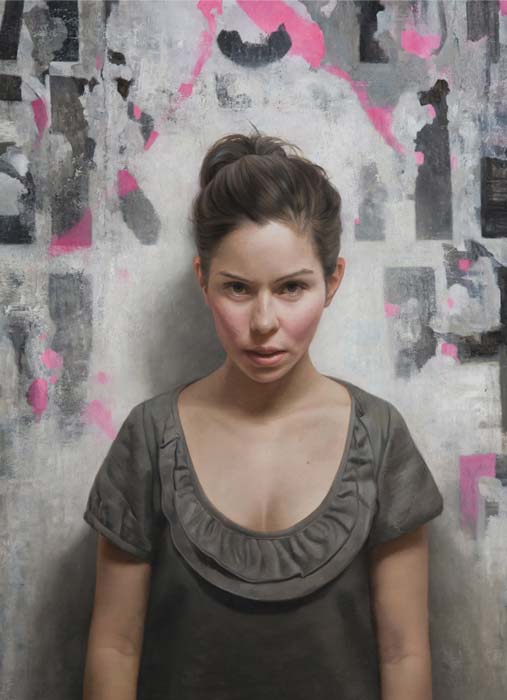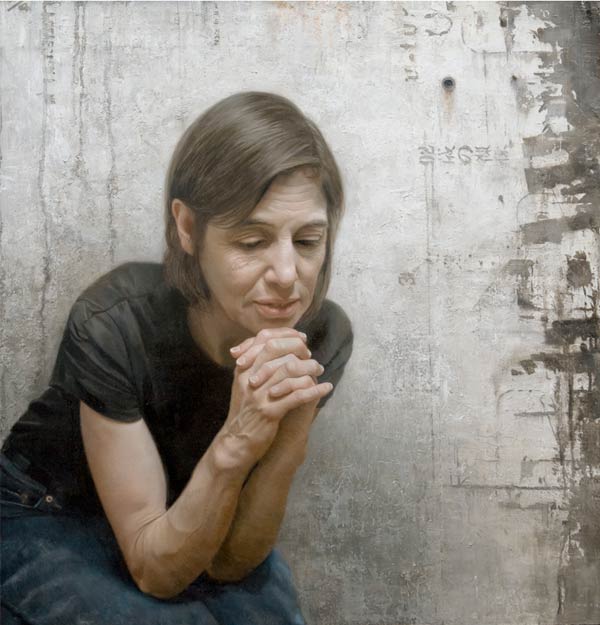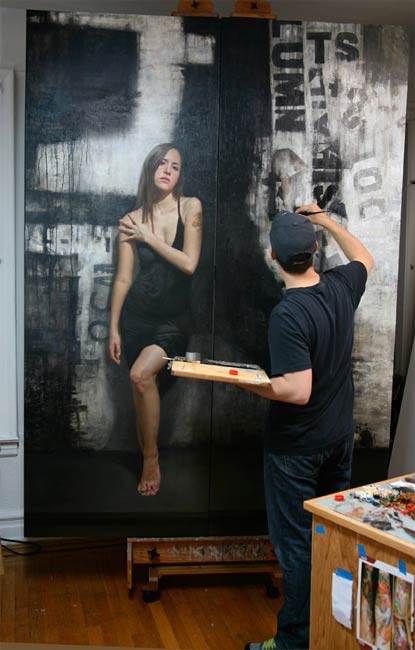David Kassan:
And I love to see early Antonio López Garcia works, where it’s just blocking in large masses. It’s real painterly and beautiful. You know, and I love lots of painters, like Jerome Witkin, and how he expresses everything, especially a pieces psychological power from his use of different brush work.
For my work, its a little bit more internalized where I want it to be the psychological power of the figure, as opposed to the medium used to create it. It’s kind of a different approach.
g>Larry Groff:
That’s one thing, David, about the Internet is that it’s, sometimes, over the computer, it’s difficult to see that subtlety
David Kassan:
Oh, yeah. Definitely.
Larry Groff:
… you know, I think that’s true for many, many painters. And sometimes it seems like it interferes with how people judge the work, sometimes. They judge the work less on it’s objectness, you know, and the various visual qualities that you see the actual painting, and more just on how kind of photo-realistically correct it might seem.

David Kassan:
Yeah, absolutely. Yeah, I think it’s just the nature of the beast. I think about what the percentage of people, you think, that actually see our paintings in real life? That’s the thing that kills me. Everyone will give me compliments on my paintings, which is really nice, and I have, I believe, a really good support system of friends and everything, But I don’t know how many of them have actually seen one of my pieces in real life. It’s interesting. Maybe 5 percent of people?
David Kassan:
Maybe less? It’s really kind of interesting, especially with the way today’s media is. I mean, I think seeing pieces before we see them in real life kind of spoils them, before you see them in real life. Imagine only seeing The Raft of the Medusa by Gericault in reproduction, and not being able to see it in real life, that would be so sad. Because when you see that painting in real life, it’s the size of a movie screen. You fall into the piece, it’s so realistic, you know? And so lifelike.

Dale, Oil on wood panel 40 x 34 inches
(Click for larger view)
Larry Groff:






Thanks Larry…another artist I’ll have to hunt down here in Brooklyn. I really enjoy seeing his interest in the graffiti/urban patterns in the backgrounds, or just as a singular focus for a painting. Seems like work that has to be seen in person to fully appreciate. Very funny hearing him talk about meeting Lopez Garcia…must have been a life changing experience…good stuff.
Thanks for this, Larry. I’ve been admiring his work for a while now. Good to hear his thoughts on it and his process.
You raised an interesting question in the interview that I’ve been thinking about lately but am having trouble getting some feedback on. What is the difference between photo-realism and super tight realism done (mostly) from life if a viewer thinks the painting is a photo? The mechanical goals of capturing exacting detail and hiding the hand of the artist seem similar to me.
Most artists treat photo-realism like a red headed step child so it just seems weird to me that there is such a resurgence of tight, classical style rendering. Is this similar to your comparison of Rackstraw Downes to Kevin Macpherson where Macpherson is selling a skill set? Is the power of David Kassan (and many other rising stars) that so many artists want to draw and paint like him so they take his classes and buy his DVD?
Interesting Comment Hank.
Of course photo-realism and other highly rendered realistic painting all have one thing in common – they are made by individuals. So I’m not sure we can easily apply blanket statements to explain the motivations. That said I think there is often a considerable difference in paintings done with the primary goal of accurately copying a photograph (or a range of photos) and paintings with a goal to capture an observed situation accurately. Photorealist paintings often emphasize features commonly seen in photographs like flatness and airlessness. The highly rendered details and smooth surface appeals to many for its apparent high level of skill and complexity and perhaps also its cool detachment and lack of overt emotional expression. Realist works like David’s may look similar as they are also highly rendered with extreme detail and even incorporate the use of photos as David does – but I think there is a difference in the treatment, the surface, and the overall tone of the painting. Some of David’s work does seem closer to photo realism when viewed online but when you see it in person it takes on a whole new experience when you see these life size and the surface. I’ve only seen a few of his paintings but as I recall the form and tonal clarity of these figures are very striking and very different that what you usually see in photorealism.
David is young and unlike many other painters is very savvy with the web’s social media and actively promotes his work and name online. I’m sure a few people may raise their eyebrows over this but I think it’s one good way to try to make a decent living as a painter. I guess you raise a valid issue that it is like Macphersons selling a skill set. I do think there are inherent dangers in pushing the whole self-marketing thing too far. He could risk people in the artworld not taking him seriously but does the artworld take any realist seriously these days? I admire his taking it all head on by himself – getting his work seen and building a large following and getting lots of attention in many of the art magazines like American Artist.
He made a very good production with his DVD. I seen a number of DVD trainings for painters, and most I’ve found either really boring, really dumb or pretentious. His dvd was actually interesting and I only found myself nodding off in a couple of places (which is saying a lot – I almost always fall asleep watching artist dvds!) Now, I’m not interested in drawing like him and probably couldn’t draw that way if I wanted to. But I found a number of things I could relate to my own type of work and it actually inspired me to do more drawing. I’m personally not interested in tight and more classical type realism and academic art really bothers me. There are quite a few painters like him selling their DVDs, workshops, demos and the like. I get so much crap like that in my email and on facebook that it makes me sick and I wind up putting a lot of it in my spam folder. The overriding emphasis on making a buck has a corrupting influence.
Of course, I am not without my criticism of his work. I like many, but not all. I’ve made a policy (up until now anyway – this may change in the future) of not really giving real art criticism here. (the Macpearson article was an earlier one when I was more open to that) I mainly have been wanting to simply showcase or review the wide variety of paintings that are being done from observation (mostly) from very tight realists like David to almost completely abstract. I’ve been thinking that maybe by the end of the year I may change this and go back to having more real criticism – but that is another story.
Thank you Larry.
What really caught my eye is this interview was actually right in the beginning when Kassan talks about the lack of expressive brushstrokes in his work. When I initially think of the statement “lack of brushstrokes”, I automatically think the absence of the artist’s hand however, I don’t believe this is what Kassan is trying to say. While he doesn’t push the bold strokes in his work, due to the fear of distracting the viewer, it is more about building textures through layers and creating a quiet-like weight to his work. This happy medium in his paintings and the way he goes on about it is very thought provoking. I really enjoyed this interview. Thanks for posting it!!
Ally- good observation. I think that many times the brushstroke is seen as the presence of the artist, but Kassan achieves presence differently. I think it’s great that Kassan is able to work directly from observation. As a student, I can attest to the difficulty of finding willing models. I really love that he becomes more involved with his model and that it shows in his paintings- he focuses on bringing out the essence of the model through his layers and removing himself so that the viewer has a direct line to the subject. All of these things combined give the work authority and make it thought provoking. I definitely think that there’s a marked difference between Kassan’s paintings and photographs and I think it comes from his process and concepts about painting/